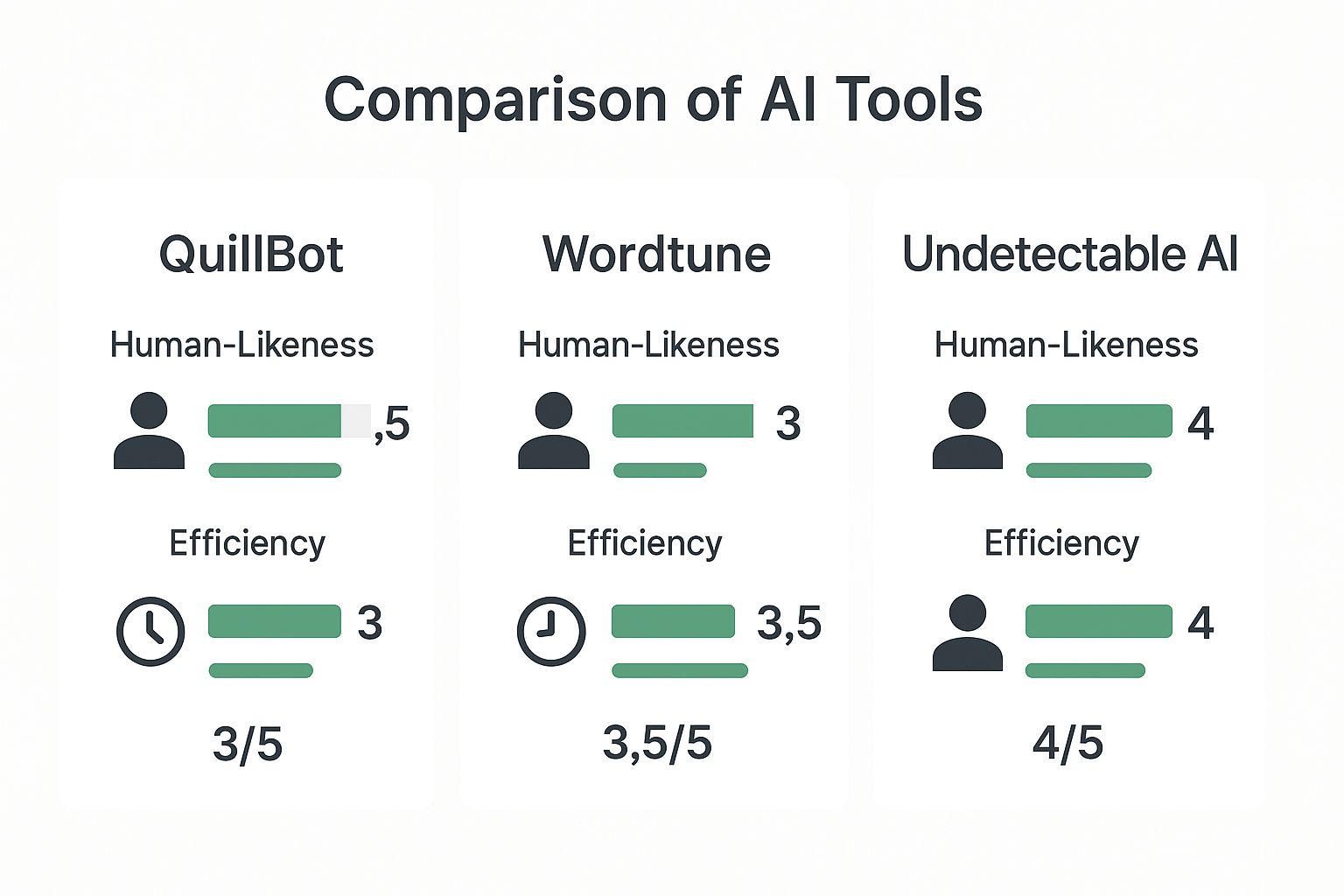
How to Make ChatGPT Undetectable: Top Strategies
October 14, 2025
To get your ChatGPT content past AI detectors, you need to understand what you're up against. Think of these tools less as magic and more as highly trained pattern-recognition systems. They've been fed mountains of text—both human and AI-generated—and have learned to spot the subtle, almost invisible signatures that large language models leave behind.
It really comes down to two key factors: perplexity and burstiness. If you can master these, you're halfway there. You need to make your text less predictable (high perplexity) and vary your sentence lengths more (high burstiness). That's how humans write.
Why AI Detectors Flag ChatGPT Content

AI detectors are basically digital detectives looking for linguistic fingerprints. For AI-generated text, these "fingerprints" are things like overly consistent sentence structures, a surprisingly narrow vocabulary, and a flow that’s logical but completely sterile. It's correct, but it has no soul.
The Concepts of Perplexity and Burstiness
Two of the biggest giveaways for these tools are low perplexity and low burstiness. Getting a handle on these is your secret weapon.
Perplexity is just a fancy word for how predictable a text is. AI models are trained to pick the most statistically likely word to come next, which creates writing that’s incredibly safe and, well, predictable. Humans? We're a mess. We use weird words, make strange connections, and surprise the reader. That's high perplexity.
Burstiness is all about rhythm and flow. It’s the natural variation in sentence length. Real people write with a mix of long, winding sentences and short, punchy ones. AI, on the other hand, often spits out paragraphs where every sentence is roughly the same length. It creates a monotonous, flat rhythm that detectors can spot a mile away.
Key Takeaway: Your goal is to dial up the perplexity and burstiness. You need to introduce less common words, mess with your sentence structures, and shatter that robotic rhythm. This is the foundation of making your content undetectable.
With ChatGPT now handling a mind-boggling 2.3 billion prompts in a single day (as of February 2025), AI detectors are getting smarter and faster. Some of the best tools out there can correctly flag over 90% of AI-generated content, making a good old-fashioned manual edit more important than ever.
Common AI Writing Patterns
Beyond the technical stuff, detectors also look for common AI habits. You know the ones—the constant use of transitional phrases like "furthermore," "in conclusion," and "it is important to note that." AI also loves to explain things in a very formulaic, step-by-step way that just doesn't feel natural.
To give you a quick reference, here are some of the most common red flags and how you can fix them manually.
Common AI Detector Triggers and How to Fix Them
| AI Detector Trigger | What It Looks For | Your Counter-Move |
|---|---|---|
| Uniform Sentence Length | Paragraphs where most sentences are around the same word count, creating a flat rhythm. | Mix it up. Write a long, detailed sentence, then follow it with a short, punchy one. Simple. |
| Predictable Word Choice | Overuse of common, safe, and generic vocabulary. The AI picks the most statistically probable words. | Swap out bland words for more vivid or specific ones. Use a thesaurus, but choose words you'd actually use. |
| Formulaic Transitions | Repetitive use of phrases like "In addition," "Furthermore," or "Therefore." | Use more casual transitions. Try starting a sentence with "But" or "And." Or just let one idea flow into the next without a formal signpost. |
| Lack of Personal Voice | The text is devoid of opinion, personality, or unique perspective. It’s objective to a fault. | Inject yourself into the writing. Add a personal anecdote, an opinion, or even a simple phrase like "In my experience..." |
| Perfect Grammar & Syntax | Flawless, textbook-perfect grammar that feels unnatural and overly polished. | Don't be afraid to bend the rules a little. Use sentence fragments. Ask rhetorical questions. Write like people talk. |
Looking at reviews of specific AI tools can also offer great insights into the different "flavors" of AI writing and what to look out for. If you want to go deeper, you can also learn more by exploring our detailed guide on how an AI detector works.
The bottom line is that you need to recognize these patterns in your own AI-generated drafts. Once you see them, you can start editing them out and injecting that much-needed human touch.
Crafting Prompts for More Human-Like Text

The single best way to make ChatGPT undetectable happens before you even generate a word. Your prompt is the blueprint for everything that follows, and a lazy prompt will always get you a generic, easily flagged response. You have to think of yourself as a director, not just an operator.
Instead of a basic command, your goal is to feed the AI a rich set of instructions that box it into a more human-like corner. This is how you move beyond simple requests and start engineering detailed prompts that guide its style, tone, and structure right from the start.
Give Your AI a Persona
The fastest way to break ChatGPT out of its default robotic voice is to give it a role to play. Don't just ask for an article; ask for an article written by someone.
This simple trick immediately forces the AI to adopt a more distinct and less predictable writing style. The persona acts as a framework for its word choice, sentence structure, and even the kinds of analogies it might use.
It’s a night-and-day difference. See for yourself:
- Weak Prompt: "Write a blog post about the benefits of remote work."
- Strong Prompt: "Write a blog post about the benefits of remote work from the perspective of a skeptical, old-school manager who was recently converted. Use a conversational, slightly informal tone and include a short personal anecdote about initially hating Zoom."
The second prompt gives the AI character, emotion, and a story to tell. What you get back is a far more unique and human-sounding draft. This small shift is a huge step toward making ChatGPT’s output fly under the radar.
Pro Tip: The more detailed you get with the persona, the better. Specify their profession, their attitude (enthusiastic, cynical, whatever), and how they feel about the topic. This depth adds layers to the writing that AI detectors just aren't built to understand.
Dictate Specific Stylistic Elements
Once you have a persona locked in, you can get even more granular by dictating specific stylistic rules. Remember, AI detectors are pattern-matching machines. Your job is to instruct the AI to break those patterns.
You can explicitly ask ChatGPT to incorporate the quirks that define natural human writing, which is often messy and imperfect. This is where you directly attack the low "perplexity" and "burstiness" that scream "AI-generated."
Try baking instructions like these directly into your prompts:
- Vary sentence length dramatically. Tell the AI to mix long, complex sentences with short, punchy ones to create rhythm.
- Use common idioms and colloquialisms. Ask it to include phrases people actually use in conversation.
- Incorporate rhetorical questions. This is great for engaging a reader and breaking up the monotony of endless statements.
- Employ contractions. Using "don't" instead of "do not" and "it's" instead of "it is" instantly makes the text feel more casual and human.
By front-loading your requests with these stylistic commands, you get a first draft that is far less sterile. It needs less manual editing and gives you a much stronger foundation to build on, which saves you a ton of time in the long run.
Giving Your Content a Human Touch

Even with the slickest prompts, the raw text from ChatGPT often feels... a little too perfect. It’s clean, grammatically flawless, and logically sound, but it’s missing the subtle quirks and imperfections that make writing feel real. This is where you step in. Your job is to manually transform that sterile text into something that actually connects with a reader.
This final editing pass is probably the most important step in learning how to make ChatGPT undetectable. You're not just correcting mistakes; you're intentionally adding a natural, slightly imperfect human voice.
Think of the AI draft as a perfectly sculpted but lifeless mannequin. Your job is to give it a personality, a unique perspective, and a bit of an edge.
Hunt Down and Replace Robotic Vocabulary
ChatGPT has its favorites. If you've spent any real time with it, you know the words I'm talking about. They’re like a giant red flag for AI detectors because they pop up constantly in machine-generated text.
Your first mission is a simple "search and destroy" for this AI-speak.
- Words to Find: Be on the lookout for overused terms like "delve," "leverage," "unveil," "harness," and "meticulous." These are dead giveaways.
- How to Replace Them: Don’t just grab the first synonym you find. Think about the real meaning. Instead of "delve into the topic," try "let's unpack this idea" or "let's get into the weeds."
Here’s a real-world example: An AI sentence might say, "We will now unveil the pivotal strategies to leverage for success." A human would say, "So, what actually works? Here are a few strategies that get real results." It's simpler, more direct, and feels authentic.
Getting this right is a big deal. The sheer volume of unmodified AI text is a growing problem, especially in schools. In the UK, nearly 7,000 university students were caught using AI to cheat in the 2023-2024 academic year. That's not all—a Turnitin review of over 200 million papers found that 11% had at least 20% AI-generated content. These patterns are easy to spot if you don't clean them up.
Break Up the Monotonous Sentence Structure
The next major giveaway is rhythm. AI models tend to write paragraphs where every sentence is roughly the same length and follows a similar structure. It creates a monotonous, hypnotic drone that screams "robot."
You need to break that rhythm. Varying your sentences creates a dynamic flow that keeps people engaged. It's the difference between a GPS voice and a captivating storyteller.
- Combine and Conquer: Find those short, choppy sentences and weave them into a longer, more complex thought.
- Break It Down: See a long, winding sentence? Chop it into two or three short, punchy ones to make a point.
- Start Differently: If you see a few sentences in a row starting with "The..." or "It is...," find a new way in.
This one technique directly improves the "burstiness" of your text, making it far harder for any algorithm to flag. If you want to dive deeper, our guide on how to humanize AI text has more advanced strategies.
Inject Your Own Voice and Perspective
Okay, here’s the most powerful move: put yourself into the content. An AI can spit out facts and figures, but it can't share a personal story, offer a genuine opinion, or tell a funny anecdote.
This is your chance to add layers no machine can ever replicate.
- Tell a quick story. Start with something like, "I remember a time when..." or "In my own experience..." It adds instant credibility.
- State your opinion. Don't be afraid to take a stance. Use phrases like, "Honestly, I think..." or "Here’s what I find surprising..."
- Ask questions. Engage the reader directly. Try something like, "But what does this actually mean for you?" or "Sounds simple, right?"
These personal touches do more than just help you bypass detectors. They build a real connection with your audience, making your content stick.
Using AI Rewriters and Paraphrasing Tools Smartly
Manual editing is the gold standard for humanizing AI text, but let's be real—sometimes you just need to get things done faster. This is where AI rewriters and paraphrasing tools come into play. A common mistake, though, is treating them like a one-click fix. That's a fast track to clunky, unnatural text that still gets flagged by detectors.
The secret is to use these tools smartly, not blindly. Instead of just pasting your text and accepting the first thing it spits out, think of the tool as a creative assistant. It’s fantastic for suggesting alternative phrasing and breaking up predictable sentence structures, but it completely lacks your context and judgment. A hybrid approach, where you combine the tool's efficiency with your own critical eye, is how you make ChatGPT text truly undetectable without killing the quality.
Choosing Your Rewriting Assistant
The market is flooded with these tools, and each has its own vibe. Some, like QuillBot, are great for spitting out a ton of synonyms and rephrasing options. Others, like Wordtune, are better at refining your tone and making sure your point is clear. Then you have specialized services like Undetectable AI, which are built from the ground up to humanize text specifically to bypass AI detectors.
The right tool really depends on your workflow. Are you just trying to find a better word, or are you looking to completely restructure a paragraph to sound more like a human wrote it? Understanding the differences is the first step. For a deeper dive, checking out an AI paragraph rewriter guide can help you nail down the perfect fit for what you're trying to do.
To give you a better idea of their core strengths, here’s a quick look at how some popular tools stack up on human-like output and raw efficiency.

As you can see, some tools are all about speed, while others put a higher premium on producing natural-sounding text. It's a trade-off you’ll need to consider.
To help you decide, here's an overview of some leading rewriters, focusing on what matters most for bypassing detection.
A Comparison of Popular AI Rewriting Tools
| Tool | Key Feature for Humanization | Best For | Potential Drawbacks |
|---|---|---|---|
| Undetectable AI | AI detection removal and humanization | Writers focused on bypassing detectors without manual edits | Can be more expensive; might alter meaning slightly |
| QuillBot | Multiple modes (Fluency, Creative, etc.) | Quickly generating several rephrased options to choose from | The "Creative" mode can sometimes sound unnatural or stray off-topic |
| Wordtune | Tone adjustment and contextual rewrites | Polishing near-final drafts for clarity and professionalism | Less focused on synonym swapping; more on structural improvements |
| NaturalWrite | Human-like phrasing and tone shifting | Injecting a more conversational, natural voice into robotic text | Primarily a humanizer, not a full-scale paraphraser |
Ultimately, the best tool is the one that fits seamlessly into your process and helps you achieve your goals faster.
A Practical Framework for Using Rewriters
Never, ever accept the AI's output as the final version. Think of it as a first draft of a rewrite, not the finished product. Your job is to iterate on the suggestions, cherry-picking the best phrases and weaving them back into your own writing. This is how the final text ends up reflecting your unique voice.
Here's a simple workflow that works wonders:
Generate Multiple Versions: Don't settle for the first suggestion. Run your text through the tool multiple times using different modes or settings (e.g., "Creative," "Formal," "Simple"). This gives you a much richer palette of words and structures to work with.
Mix and Match: Pull the best bits from each version. You might love the opening sentence from one suggestion and a killer phrase from another. Combine them to build a stronger, more dynamic paragraph than any single output could provide.
Perform a Final Human Polish: After you've pieced together your new version, always do one last read-through. Your goal is to hunt down any awkward phrasing, logical gaps, or leftover robotic tone. This is your last chance to inject that crucial human element.
Key Insight: The best results come from a layered approach. Use ChatGPT for the initial draft, an AI rewriter for structural variety, and your own expertise for the final polish. This method streamlines the process without sacrificing authenticity.
When you look at the broader world of AI social media content creation, a clear pattern emerges: the best stuff happens when a human is guiding the AI. By treating these tools as assistants rather than replacements, you can scale your content production and still create high-quality work that flies under the radar.
Your Final Checklist for Bypassing AI Detection
https://www.youtube.com/embed/msx5S0xFxWs
You’ve done the hard work of prompting, editing, and humanizing your text. Now you're in the home stretch, but how can you be absolutely sure it’s ready to go live?
This last phase is all about verification. Think of it as a final quality check to make sure your work not only sails past AI detectors but also reads beautifully for your audience. You wouldn't launch a rocket without a pre-flight check, and you shouldn't publish content without this final step.
Run Your Text Through a Few Different Detectors
First things first, let's use the AI detectors themselves as our final checkpoint. Don’t just rely on a single tool. Different platforms have slightly different algorithms, so one might catch something another misses. Running your text through two or three gives you a much more reliable verdict.
A few solid options to try are:
- GPTZero: Widely considered one of the more accurate detectors out there. It gives you a clear, easy-to-understand score.
- Originality.ai: This is a paid tool, but it's powerful. Many pros rely on it for its high accuracy.
- Copyleaks: A great free option that provides a straightforward probability of whether the text is human or AI-generated.
Just paste your final draft into these tools and see what they say. If you're consistently getting a high "human-written" score across the board, you can feel pretty confident in your work. This cross-check is your best defense against a false positive from any single service.
Use the Results to Make Final Tweaks
If a detector flags a part of your text, don’t sweat it. Instead, use it as a guide for one last polish. Most of these tools will highlight the specific sentences or phrases that set off their alarms.
Go back and look at those flagged sections with a critical eye. More often than not, it's an area where a slightly unnatural phrase or a predictable sentence structure managed to slip through. A small adjustment—like swapping a generic word for a more vivid one or just changing the syntax—is usually all it takes.
Crucial Insight: Remember, the goal isn't just to fool an algorithm. A flagged sentence is often a signal of weak or clunky writing. By fixing it, you're not just bypassing a detector; you're making the content better and more readable for an actual person.
The Final Human Read-Through
This is the last and, honestly, the most important step: read the entire piece out loud.
It sounds simple, but it’s an incredibly effective way to catch anything that feels awkward, robotic, or just off. Your ears will pick up on clunky rhythms and unnatural phrasing that your eyes might have skimmed right over.
Does it flow? Does it sound like something a real person would actually say? If you find yourself stumbling over a sentence or cringing at a word choice, it needs one last touch-up. This final, intuitive check is what ensures your content is not only undetectable but genuinely engaging, too.
A Few Common Questions
When you're trying to get AI content past detectors, a few questions pop up again and again. Here are some quick answers based on what I've seen work.
Is It Possible to Make AI Content 100% Undetectable?
The short answer is yes, but it’s not a one-click fix. You can't rely on a single tool or a clever prompt and expect to get a 100% human score every time. That's especially true for the tougher detectors like Originality.ai.
The only approach that consistently works is a layered one. You start with a great prompt, run the output through a humanizer, and then—this is the critical part—do a final manual edit. That last pass is where you inject your unique voice and smooth out any lingering weirdness. When you combine those steps, the text becomes statistically identical to something a person would write.
Does Google Actually Detect AI-Generated Content?
Yes, Google can spot AI content. But here's the thing: they don't really care how it was made. They care about its quality.
Google’s main goal is to get rid of spammy, low-value content. Their systems, like SpamBrain, are built to penalize text that doesn't help the reader, regardless of whether a human or an AI wrote it.
The Bottom Line: If your AI-assisted content is genuinely helpful, original, and well-written, you're playing by Google's rules. The red flag for them is the generic, unedited AI output that adds zero value.
What’s the Best Way to Humanize AI Text?
The most effective method is a hybrid one. It's a three-part process that balances speed with quality.
- Start with a strong first draft. Use a detailed, persona-driven prompt to get the best possible output from the AI.
- Use a good AI humanizer. Let a tool handle the heavy lifting—restructuring sentences, swapping out predictable words, and varying the rhythm.
- Do a final manual read-through. This is where you add personal stories, opinions, or unique phrases that no AI could ever come up with on its own. It's what makes the content truly yours.
This layered process doesn't just help you bypass detectors. It turns a generic AI draft into something genuinely engaging that people will actually want to read. That final human touch is what separates decent content from great content.
Ready to turn your AI text into something that sounds genuinely human? Natural Write offers a free, one-click solution to humanize your writing. It helps you get past AI detectors while keeping your original ideas intact. It’s perfect for students, marketers, and writers who need to refine their work instantly. Give it a try and see the difference at https://naturalwrite.com.


